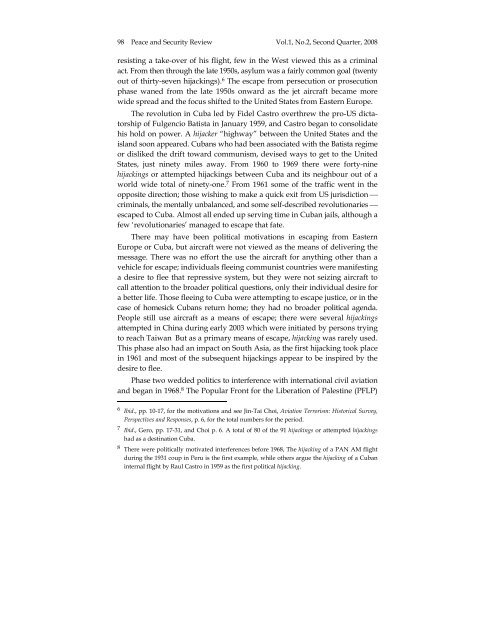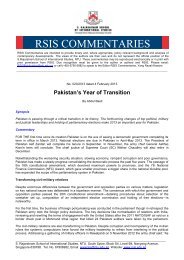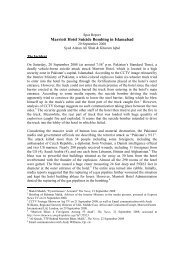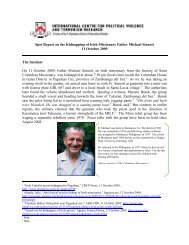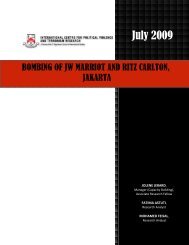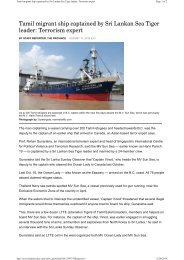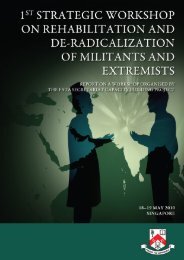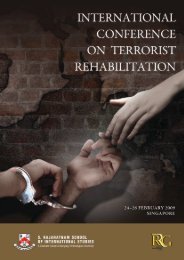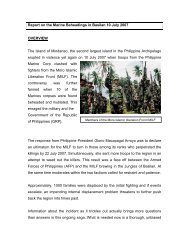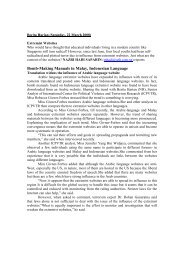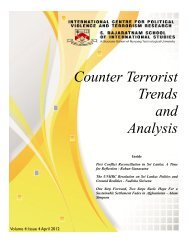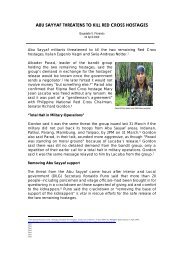Peace and Security Review, Vol.1 No. 2 - International Centre for ...
Peace and Security Review, Vol.1 No. 2 - International Centre for ...
Peace and Security Review, Vol.1 No. 2 - International Centre for ...
Create successful ePaper yourself
Turn your PDF publications into a flip-book with our unique Google optimized e-Paper software.
98 <strong>Peace</strong> <strong>and</strong> <strong>Security</strong> <strong>Review</strong> <strong>Vol.1</strong>, <strong>No</strong>.2, Second Quarter, 2008<br />
resisting a take-over of his flight, few in the West viewed this as a criminal<br />
act. From then through the late 1950s, asylum was a fairly common goal (twenty<br />
out of thirty-seven hijackings). 6 The escape from persecution or prosecution<br />
phase waned from the late 1950s onward as the jet aircraft became more<br />
wide spread <strong>and</strong> the focus shifted to the United States from Eastern Europe.<br />
The revolution in Cuba led by Fidel Castro overthrew the pro-US dictatorship<br />
of Fulgencio Batista in January 1959, <strong>and</strong> Castro began to consolidate<br />
his hold on power. A hijacker “highway” between the United States <strong>and</strong> the<br />
isl<strong>and</strong> soon appeared. Cubans who had been associated with the Batista regime<br />
or disliked the drift toward communism, devised ways to get to the United<br />
States, just ninety miles away. From 1960 to 1969 there were <strong>for</strong>ty-nine<br />
hijackings or attempted hijackings between Cuba <strong>and</strong> its neighbour out of a<br />
world wide total of ninety-one. 7 From 1961 some of the traffic went in the<br />
opposite direction; those wishing to make a quick exit from US jurisdiction ⎯<br />
criminals, the mentally unbalanced, <strong>and</strong> some self-described revolutionaries ⎯<br />
escaped to Cuba. Almost all ended up serving time in Cuban jails, although a<br />
few ‘revolutionaries’ managed to escape that fate.<br />
There may have been political motivations in escaping from Eastern<br />
Europe or Cuba, but aircraft were not viewed as the means of delivering the<br />
message. There was no ef<strong>for</strong>t the use the aircraft <strong>for</strong> anything other than a<br />
vehicle <strong>for</strong> escape; individuals fleeing communist countries were manifesting<br />
a desire to flee that repressive system, but they were not seizing aircraft to<br />
call attention to the broader political questions, only their individual desire <strong>for</strong><br />
a better life. Those fleeing to Cuba were attempting to escape justice, or in the<br />
case of homesick Cubans return home; they had no broader political agenda.<br />
People still use aircraft as a means of escape; there were several hijackings<br />
attempted in China during early 2003 which were initiated by persons trying<br />
to reach Taiwan But as a primary means of escape, hijacking was rarely used.<br />
This phase also had an impact on South Asia, as the first hijacking took place<br />
in 1961 <strong>and</strong> most of the subsequent hijackings appear to be inspired by the<br />
desire to flee.<br />
Phase two wedded politics to interference with international civil aviation<br />
<strong>and</strong> began in 1968. 8 The Popular Front <strong>for</strong> the Liberation of Palestine (PFLP)<br />
6 Ibid., pp. 10-17, <strong>for</strong> the motivations <strong>and</strong> see Jin-Tai Choi, Aviation Terrorism: Historical Survey,<br />
Perspectives <strong>and</strong> Responses, p. 6, <strong>for</strong> the total numbers <strong>for</strong> the period.<br />
7 Ibid., Gero, pp. 17-31, <strong>and</strong> Choi p. 6. A total of 80 of the 91 hijackings or attempted hijackings<br />
had as a destination Cuba.<br />
8 There were politically motivated interferences be<strong>for</strong>e 1968, The hijacking of a PAN AM flight<br />
during the 1931 coup in Peru is the first example, while others argue the hijacking of a Cuban<br />
internal flight by Raul Castro in 1959 as the first political hijacking.<br />
<strong>Vol.1</strong>, <strong>No</strong>.2 2008 pp.95-114


